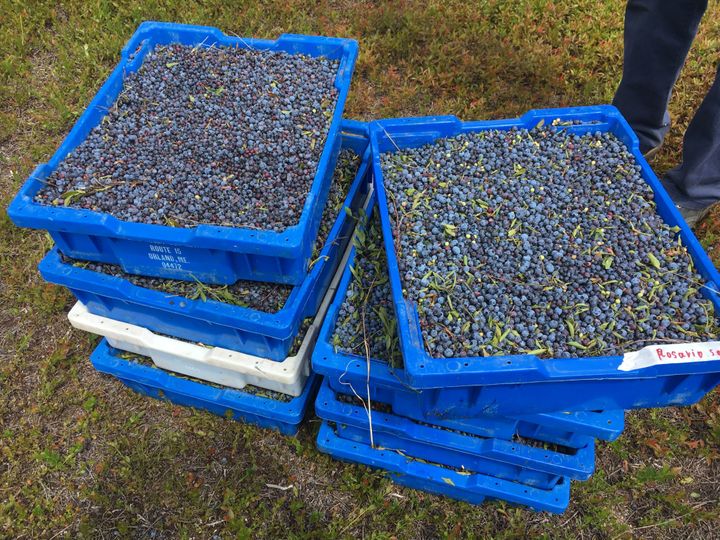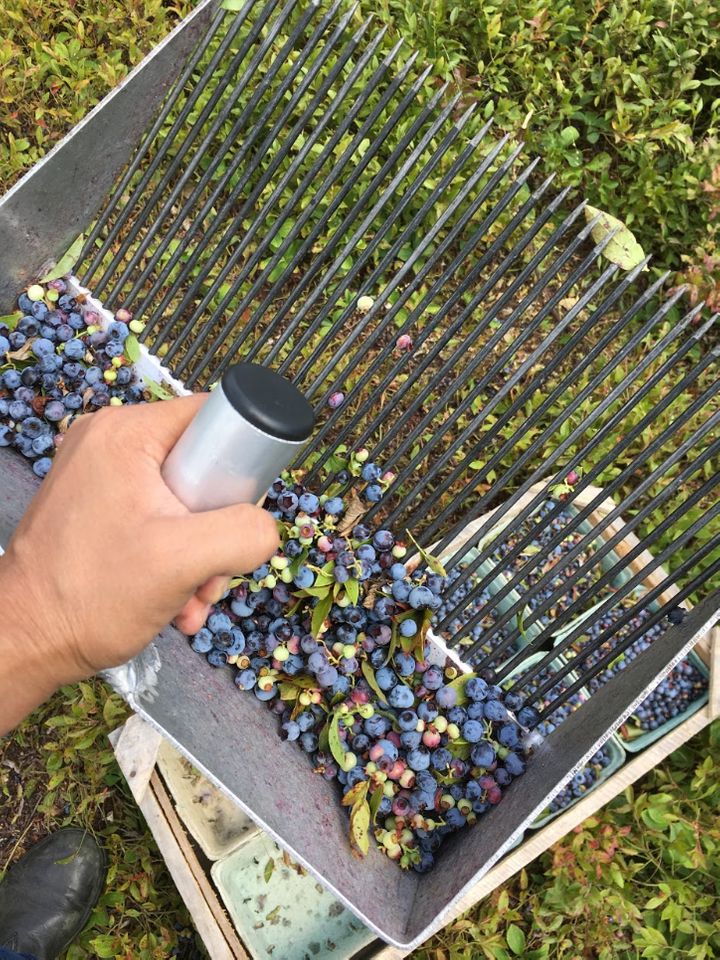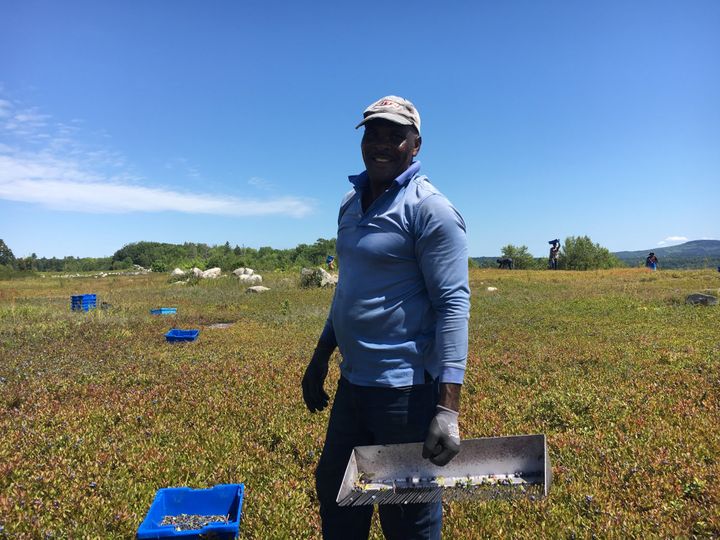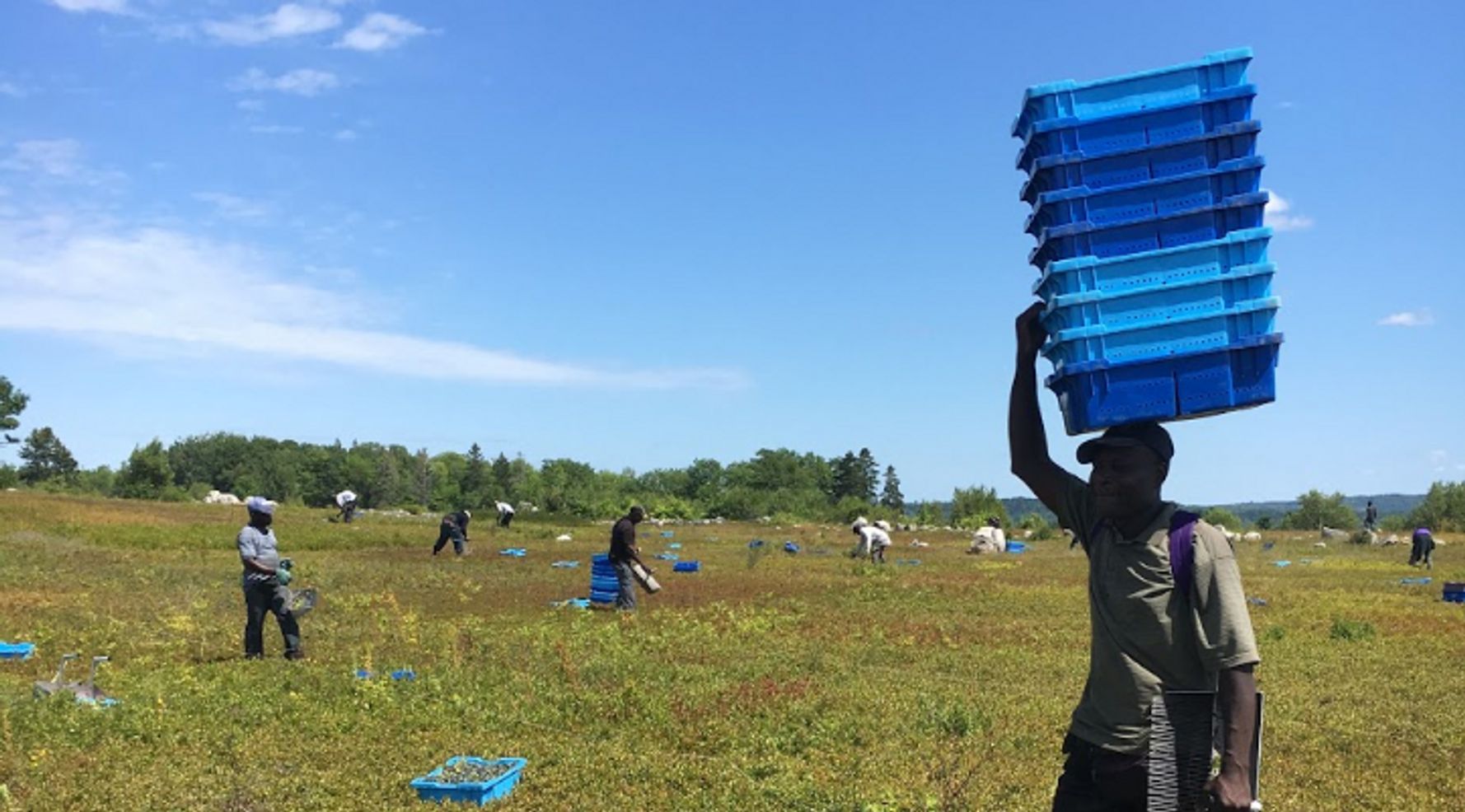[ad_1]
Growing wild in the fields of the Wabanaki and Penobscot tribal nations in Washington County, Maine, wild blueberries have become synonymous with the state. And these small berries represent not only a symbol of Maine’s identity, but also larger metaphors of identity and changing populations in the United States today.
Fruit picking, as an industry, is supported on the backs of seasonal migrant workers, many of them hailing from the countries that have been vilified by our current political administration. Yet their contribution to the U.S. economy and agriculture cannot go unrecognized, and to do so would be to disregard understanding where our food comes from.
I recently arranged a trip to visit two independent growers, John Allen of Allen’s Wild Blueberries in Orland, Maine, and Courtney Hammond of Lynch Hill Farms in Harrington, Maine. I spoke with some of their crews in Down East Maine, a region that happens to be in one of the more remote areas of an already very white and rural state. It’s so isolated that people not from the county are dubbed “from away.”
We stopped to chat at one of Allen’s fields, where Trump 2020 flags billowed in the breeze off the raking tractor and the man who came to meet us had a red MAGA hat on, faded from the sun. Allen explained to me that he and most other independent growers must pay for labor, equipment and all the upfront costs associated with raking blueberries for the short harvest in the month of August. After processing and selling, the larger corporations that sit on the Maine blueberry council decide the market price for the year. Many farmers often won’t receive a check for the crop until the end of November.
And last year, Hammond ended up in a $20,000 deficit. Seeing deficits and hardship as the price of the berry fluctuates, he and others have begun to push for change.

The industry to harvest wild, low bush Maine blueberries is like the fruit itself: precarious and on the cusp of change. Blueberries have driven Maine’s easternmost region’s economy, and literally built a frozen fruit empire. Unlike the larger, high bush blueberries we are familiar with at the grocery store, in their clear, plastic clamshell boxes, low bush, wild blueberries are sweeter and smaller with higher levels of antioxidants.
Maine blueberries have always been a money-making crop but in 2016, after years of producing hundreds of millions of pounds of blueberries, the market price dropped as Canadian berries flooded the market. Then a few years of drought and frost, plus an aging population in rural Maine had many questioning the stability of the blueberry industry for independent growers.
This means that the stream of seasonal workers will also have to adapt. For decades now, workers of all kinds and from all walks of life have come here to rake blueberries.
A Day In The Fields
Allen’s Wild Blueberries is the state’s smallest grower/processor. Allen, the owner, manages about 1,200 acres of blueberry barrens (the fields where blueberries grow), and he plans to rake and process about 1.5 million pounds this year. Most of the berries are frozen and sold wholesale across the Eastern Seaboard, primarily to bakeries, and he aims to have 50,000 pounds picked and processed a day. In order to do that, Allen relies on Jean Piton, a Haitian crew boss, or recruiter, who he’s been working with since 2005.
For almost 24 years, Piton has managed 200-300 workers from across Haiti, Florida and New York. Every year in early spring, Allen gets in touch with Piton and lets him know how many workers he’ll need. This year, he brought 45 people to Allen’s; four to five men take the berries off the truck and pour them onto the assembly line where they are cleaned, sorted by laser and processed by 12 to 13 women who pick the berries off the line, and other workers in the fields do the raking. Piton brings them up in vans and drops people off here and there on their route. On your average day in the fields, blueberry raking begins at 5:30 a.m. and ends at 2 p.m. before it gets too hot. Factory workers, primarily women, begin picking on an assembly line and packing at 8 a.m. and will continue until all the blueberries have been processed for the day. This can mean they are on the line until 9 p.m., as wild blueberries have a short shelf life and need to be processed quickly.

Manu, one of the only field workers who speaks a bit of English (most speak Haitian Creole and/or French), is originally from Haiti but based in Sebring, Florida, when he’s not doing seasonal work. Manu will probably rake around 40 boxes on this particular day. Each worker is paid out per box (the boxes can carry approximately 21 pounds of berries) at a price set by the owner.
Allen said wild blueberries pay the best compared to other crops, making it worth the worker’s while to come to Maine and pick, with some workers making $300 a day. Piton, the crew boss, said that while blueberries can bring in several hundred dollars a day, the price of picking citrus in Florida is so low that he’s stopped taking a crew there.
The Uncertainty Of Life As A Picker
This crew will be in Maine for low bush blueberry raking until September when Piton will move on to New York with a crew to pick apples. He’ll drop a few of his workers in New Jersey to pick the high bush blueberries and bring others with him to the apple orchard. This year, the apple orchard he has worked with for over 24 years has cut his crew in half. If apples don’t work out this year, he’s going to give up on apple picking like he did with citrus fruits in Florida. When asked where he would go, he simply replied “back home” to either Florida or Haiti (Piton is a naturalized U.S. citizen). He would wait it out until spring or look for work in tobacco in North Carolina until the blueberry season starts up again.
Informal networking helps Hammond of the Lynch Hill Farms in Harrington to find his seasonal workers year after year. When asked how he finds his seasonal employees, he chuckled and said, “Facebook.” Every year, like Allen, Hammond keeps in touch with workers that have come the season before.
At Lynch Hill Farms, a family of five, including three teenage children, works in the fields ― they come during the summer to rake blueberries before returning home for broccoli harvest in Aroostook County while the children to attend school. Harvesters need to be at least 12 years of age to be able to work in the fields.
Then there’s Alberto, who is originally from Puerto Rico but chose to stay in Maine six years ago, after his first blueberry harvest. He likes it here because of the shifting seasons and finds the blueberry harvest, while physically demanding, to pay more and provide better support than other jobs since the work includes medical attention, legal advocacy and educational information for workers.
Elder, a 28-year-old worker from Honduras, said he and his girlfriend have done this seasonal route for two summers now, and he proudly rakes around 60 boxes a day. He plans to pick high bush blueberries in New Jersey before returning to Florida, where he works in construction on the off-season.

As Hammond put it, “the blueberry industry is standing at the edge of a cliff” as market prices decline and small farms begin to close. For migrant workers and their families, there is some support as they make their decision of whether to stay: Mano en Mano is an organization that works with the U.S. Department of Labor to bring the Blueberry Harvest School, a summer program, to Washington County.
Ian Yaffe, executive director of Mano en Mano, explained that due to how the blueberry harvest takes place in August, the organization creates programming to support students, who are either the children of the field workers or young harvesters themselves. Yaffe says celebrating their identities ensures they’ll be successful when they do return to school in their permanent residence. A bus picks children up from the farms and camps where they work and live, and the program, as Hammond describes it, also functions “as a sort of daycare” for those under 12 who are too young to work in the fields.
Year after year, Yaffe sees many of the same students returning and believes this is important work. “These are brown and black students, of seasonal workers, doing work people don’t value,” he said. “We want to make sure they celebrate these identities and understand they are important.”
The True Cost Of Mechanization
And the work their families do is important. Blueberry raking is brutal, requiring physically laboring over a hand rake in the hot sun, made all the more difficult with the uncertainty of the industry and seasonality of the work. Both Allen and Hammond value the crew that comes back year after year, but some farms are starting to value mechanization over people.
On level ground, a tractor can rake fields, leaving workers out of jobs. Larger corporations such as Cherryfield Foods has already done away with hand raking altogether.
This, however, comes at a cost. As we walked through Hammond’s fields, I could see fields across the way that had been raked by the tractor ― but the land was dryer and more berries had been left on the bushes.
And while it costs money to invest in machinery, it also costs the local economy as migrant workers and their economic contributions may no longer return to the region. In 2017, blueberry prices were so low that the Passamaquoddy Wild Blueberry Company had to leave its fields to the birds; the company didn’t pick a single berry. During that particular season, Hammond recalls the general stores in the area losing a quarter of their seasonal revenue and the surrounding economy has since struggled to recover.

Though some detractors would like you to believe it, migrant workers from different countries aren’t stealing jobs. Rather, large companies that mechanize and drive down prices are eliminating jobs, making migrant families become irrelevant for the industry.
Hope For The Future
There is one glimmering hope in what appears to be an industry gone to the wayside: the migrant families that have settled in Washington County.
In the past 10 years since Mano en Mano was established, there is now a growing Latinx population in Down East Maine that works in the blueberry, seafood and hospitality industries.
Yaffe said the local elementary schools are now almost 30% Latinx and much of the community has settled, starting restaurants and other local businesses. Hammond mentioned a blossoming Mexican restaurant, Vasquez, that actually started as a food stand for seasonal workers in the middle of the blueberry fields.
And so it appears, the communities and networks that the blueberry industry has created will hopefully also be the ones who can save the local economy. If these younger, once seasonal families are able to settle, Down East Maine’s migrant population could keep the area’s industries alive.
[ad_2]
Source link

